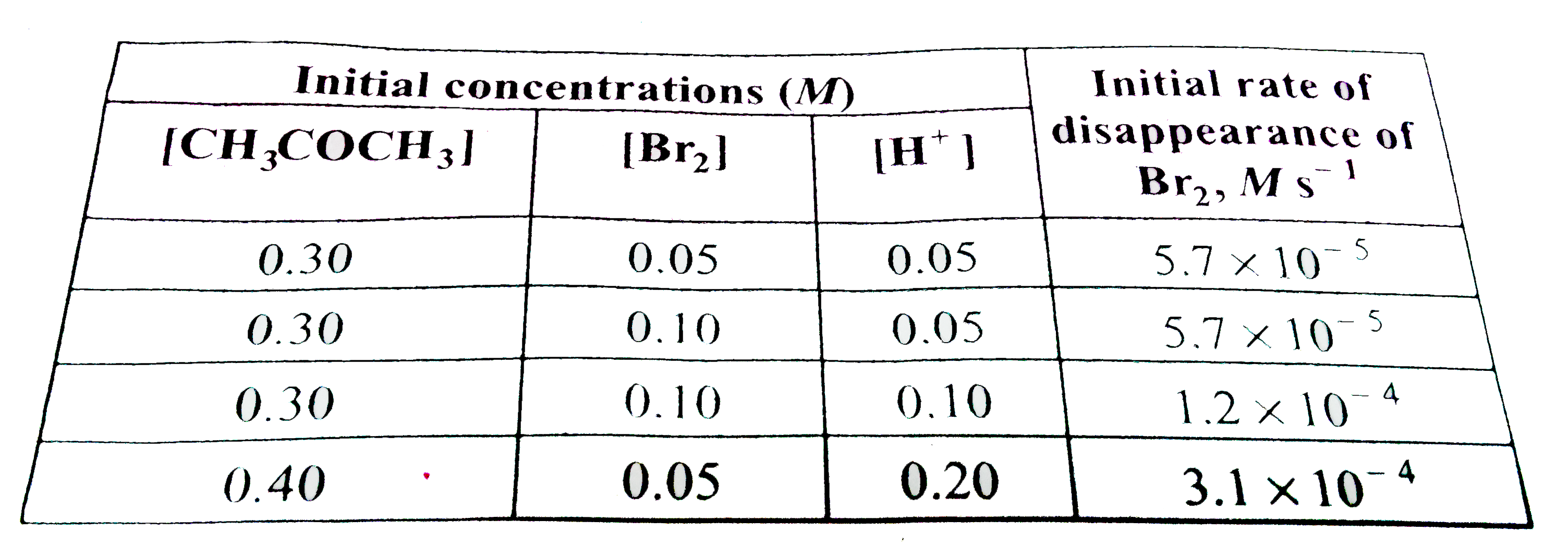अभिक्रिया
5Vr−(aq)+BrO−3(aq)+6H+(aq)→3Br2(aq)+3H
के लिए निम्न दर व्यंजक पाया गया
−d[BrO3−]dt=k[Br−][H+]2[BrO(3)−]
निम्नलिखित में से कौन सा कथन सही है/हैं?
। सभी अभिकारकों की प्रारंभिक सांद्रता को दोगुना करने पर अभिक्रिया की दर में 8 गुणक की वृद्धि होगी।
II. एक बफर विलयन में अभिक्रिया के वेग स्थिरांक की इकाई मिनट−1 है।
III. सभी अभिकारकों की सांद्रता को समान समय पर, दोगुना करने पर अभिक्रिया की दर में 16 के गुणक से वृद्धि होगी।
IV.BrO−3 के रूपांतरण की दर और Br के विलुप्त होने की दर समान हैं।
l और ll
ll और lll
ll और lV
केवल lll
The correct Answer is:D
r=−d[BrO−3]dt=13d[Br2]dt
r=K([Br−])([H+])2([BrO−3])
r=K(2[Br−](2[H+])2(2[BrO−3])=16r
Topper's Solved these Questions
Similar Questions
कक्षीय आरेख, जिसमें पाउली अपवर्जन सिद्धांत और हुंड नियम दोनों का उल्लंघन होता है:
View Solutionनिम्न में से नाइट्रोजन युक्त बहुलक कौनसा है?
View SolutionThe bromination of acetone that occurs in acid solution is represented by
CH3COCH3(aq.)+Br2(aq.)→CH3COCH2Br(aq.)+H+(aq.)+Br−(aq.)
These kinetic data were obtained for given reaction concentrations :

Based on these data, rate equations is :
View SolutionIn the reaction BrO_(3)^(-) (aq) + 5 Br^(-) (aq) + 6 H^(+) to 3 Br_(2) (l) + 3H_(2)O (l) The rate of appearing of bromine (Br_(2)) is related to rate of disappearance of bromide ions as following
View Solutionunderset("(aq)")(MnO_(4)^(-)) + underset("(aq)")(Br^(-)) to underset("(aq)")(MnO_(2))+ underset("(aq)")(BrO_(3)^(-))
View SolutionMnO−4+H++Br−→Mn3+(aq.)+Br2↑⏐⏐
View SolutionIn the reaction, BrO−3(aq)+5Br−(aq)+6 H+→3 Br2(l)+3 H2O(l),
the rate of appearance of bromine (Br2) is related to the rate of disappearance of bromide ions as follows :
View SolutionWhich of the following expressions is correct for the rate of reaction given below ? 5" Br"^(-)("ap")+"Br"O_(3)^(-)(ap)+6H^(+)(aq)to3" Br"_(2)(aq)+3H_(2)O(l)
View SolutionThe order of the reaction
5 Br−(aq)+BrO−3(aq)+6 H+(aq)→3 Br2(aq)+7 H2O(l) is
View SolutionFor the reaction
5Br(aq)+BrO−3(aq)+6H+(aq)→3Br3(aq)+3H2O(l)
If, −Δ[Br]Δt=0.05molL−1min−1,−Δ[BrO3]Δt∈molL−1min−1is
View SolutionPredict if the reaction between the following is feasible :
Fe3+(aq) and Br−(aq)
View Solutionअभिक्रिया BrO−3(aq)+5Br−(aq)+6H+→3Br2(l)+3H2O(l) में, ब्रोमीन (Br2) के प्रगटीकरण की दर, ब्रोमाइड आयनों के लुप्त होने की दर से निम्न प्रकार संबंधित है
View SolutionThe bromination of acetone that occurs in acid solution is represented by this equation.
CH3COCH3Br(aq)+Br2(aq)→
CH3COCH2Br(aq)+H+(aq)+Br−(aq)
These kinetic data were obtained for given reaction concentrations.
Initial concentrations, M
[CH3COCH3][Br2][H+]Initial rate, disappearance of Br20.300.050.055.7×10−50.300.100.055.7×10−50.300.100.101.2×10−40.400.050.203.1×10−4
Based on these data, the rate equation is
View SolutionStatements: Bromide is a reducing agent in the following reaction. 2MnO_(4)^(-)(aq)+Br^(-)(aq)+H_(2)O to2MnO_(2)(aq)+BrO_(3)^(-)(aq)+2OH^(-)(aq) Reason: Oxidation of Br increases from -1 to +5.
View SolutionMnO_(4)^(-)+H^(+)+Br^(-) to Mn^(3+)(aq.)+Br_(2)uarr
View SolutionMnO_(4)^(-)+H^(+)+Br^(-) to Mn^(3+)(aq.)+Br_(2)uarr
View Solution